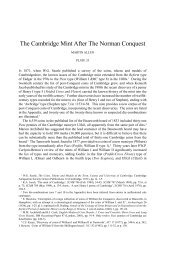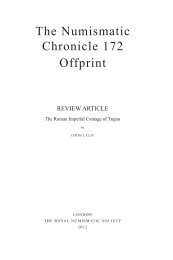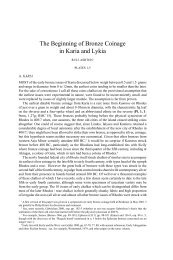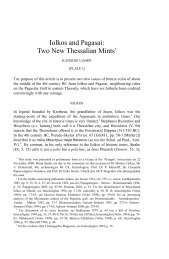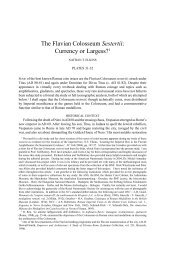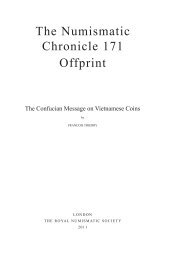The Numismatic Chronicle 171 Offprint - Royal Numismatic Society
The Numismatic Chronicle 171 Offprint - Royal Numismatic Society
The Numismatic Chronicle 171 Offprint - Royal Numismatic Society
You also want an ePaper? Increase the reach of your titles
YUMPU automatically turns print PDFs into web optimized ePapers that Google loves.
106<br />
8. Weights<br />
RICHARD SCHAEFER and ANDREW McCABE<br />
Analysis of the star coin weights raises complex problems. We have surveyed coins<br />
from published and internet auctions over the last decade as well as from major<br />
public collections. 7<br />
Although there are suffi cient weight data on the easily distinguished RRC 113/2<br />
and RRC 196/1 as, and the RRC 113/3 and RRC 196/2 semis, the data available for<br />
other fractions is very limited. For example Michael Crawford’s archived papers<br />
in the British Museum indicate that he considered two star-above trientes in Paris,<br />
weighing 10.70 and 10.41g, and eight star-before trientes in Paris and Hannover<br />
weighing an average 6.93g. 8 Weights for quadrantes cannot be accepted sight-unseen,<br />
given the variable design features. Sextantes are so rare as to defy weight analysis.<br />
At fi rst glance the limited trientes data seem to support the existing classifi cation.<br />
However many of the Paris coins are very worn, and thus best not included in the data.<br />
A wider survey of well-preserved pieces which we have viewed in person or from<br />
photographs shows that the offi cial smaller fractions, as opposed to the unoffi cial<br />
quadrantes, cannot be distinguished by weight between Period 1 and Period 2, nor<br />
by diameter.<br />
For each type we give the sample size and the average weight (mean). As sample<br />
sizes are small, we have calculated a ‘90% confi dence range’ for the mean – within<br />
which the mean of a theoretically large sample should (with 90% confi dence) fall. If<br />
the ‘90% confi dence range’ of two issues do not overlap, the issues were probably<br />
made to different weight standards. If the ‘90% confi dence range’ of two issues<br />
overlap, it is our view that the two issues cannot be distinguished by weight alone.<br />
Weights are rounded to the nearest half gram: it is not statistically meaningful to be<br />
more precise.<br />
RRC 113/2 as: 14 coins averaging 33½ g (90% confi dence range is 31 to 36g)<br />
RRC 196/1 as: 39 coins averaging 22½ g (90% confi dence range is 21½ to<br />
23½ g)<br />
RRC 113/3 semis: 3 coins averaging 15g (90% confi dence range is 14 to 16 g)<br />
RRC 196/2 semis: 20 coins averaging 13½ g (90% confi dence range is 13 to<br />
14½ g)<br />
Star-before triens: 6 coins averaging 7½ g (90% confi dence range is 6 to 9 g)<br />
Star-above triens: 9 coins averaging 9 g (90% confi dence range is 8 to 9½ g)<br />
Star-before quadrans offi cial issue: 4 coins averaging 7g (90% confi dence range<br />
is 6 to 8g)<br />
Star-above quadrans: 6 coins averaging 6½ g (90% confi dence range is 6 to 7g)<br />
Star-before quadrans, later small change: 37 coins averaging 4½ g (90%<br />
confi dence range is 4 to 4½g)<br />
Insuffi cient sextantes were available to include in the data.<br />
7 Public collections: ANS, Bibliothèque Nationale (Paris), Kestner Museum (Hannover), and Museo<br />
Civico (Milan). Private collections: Russo, Witschonke, Goodman, McCabe, Blume-Poulton and<br />
others.<br />
8 Michael Crawford, archive of notes compiled in the preparation of Roman Republican Coinage,<br />
British Museum.



